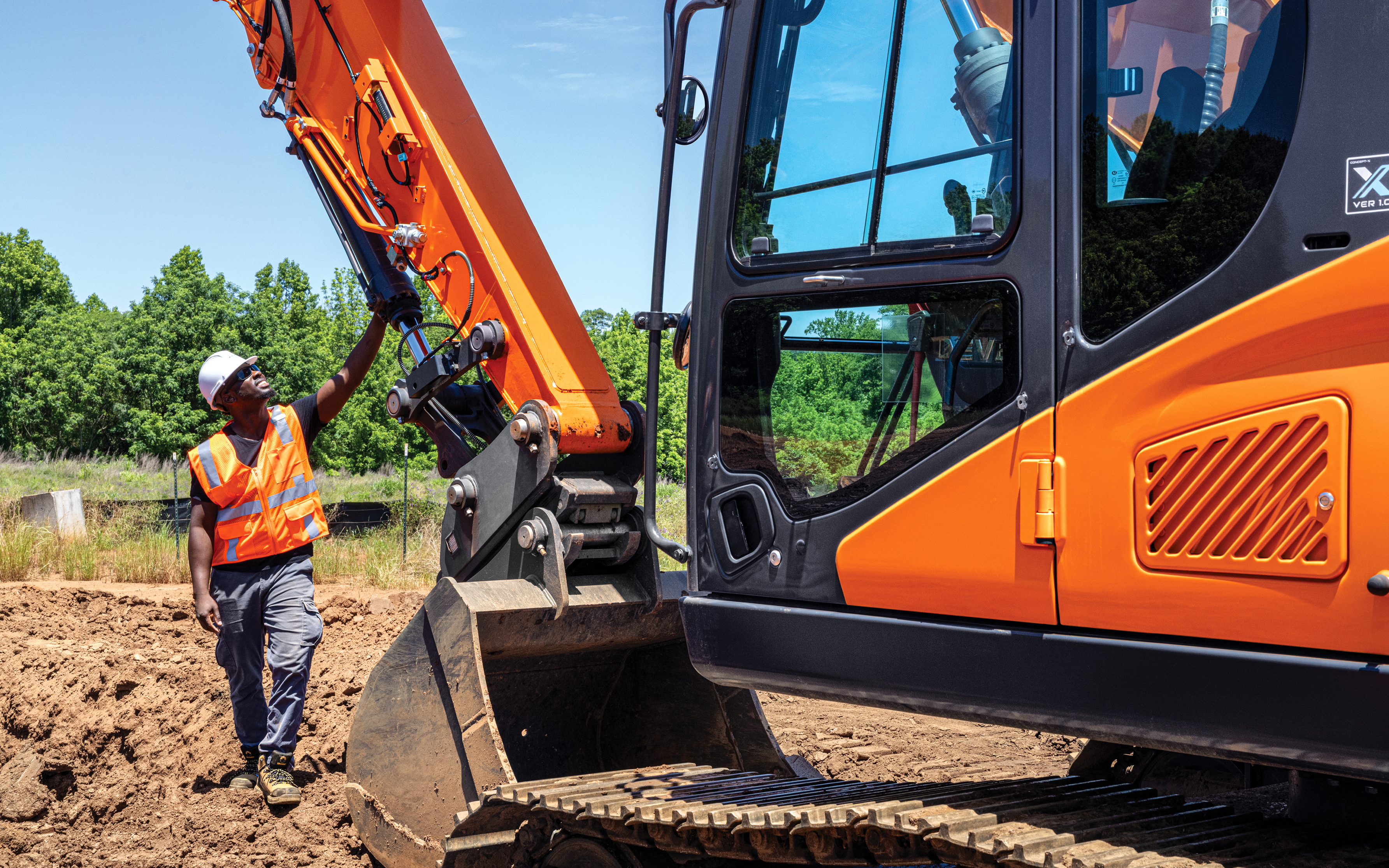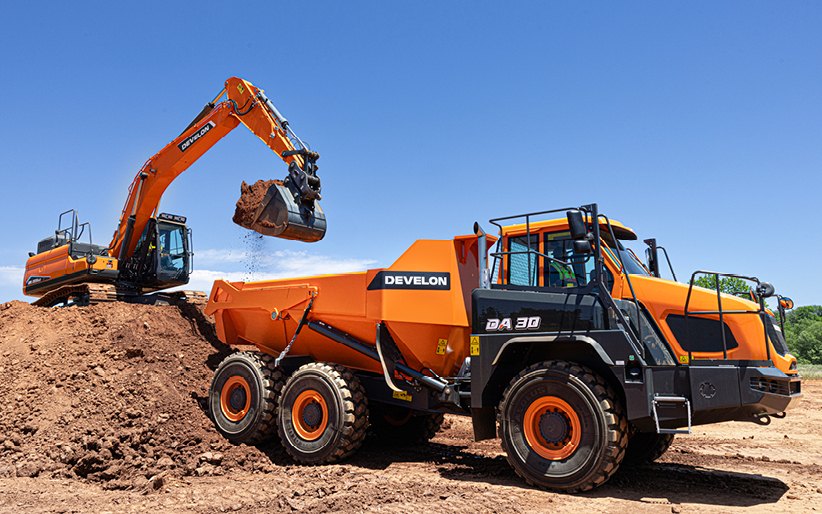A dozer serves as a workhorse in construction and other earthmoving projects, excelling in tasks such as pushing soil, grading surfaces and leveling terrain. Components like the undercarriage and blade type and design play a critical role in determining its durability, stability and overall performance to navigate various terrains on job sites.
Here are a few characteristics of durable dozers.
Robust Dozer Undercarriage Design
The design of a dozer’s undercarriage plays a critical role in determining its durability, stability, operating costs and overall ability to navigate various terrains on job sites. A dozer’s undercarriage may include different track lengths and widths, as well as track shoe types, depending on the specific needs of the application or terrain.
One key element is the dozer tracks. Tracks distribute the dozer’s weight over a larger surface area, reducing ground pressure and minimizing the risk of the machine sinking into softer soils. Manufacturers like DEVELON offer tracks that can be tailored to specific working conditions and soil types. General-purpose and full-guard track guard options are available for exceptional performance and uptime protection.
Rollers and idlers support the tracks and ensure proper alignment. Durable, well-designed rollers contribute to smoother track motion, reducing wear on the tracks and the undercarriage. Some manufacturers offer single- and dual-flange rollers to improve durability and extend component life. Idlers, positioned at the front and rear of the undercarriage, guide the track and help maintain tension. A robust idler system is crucial for preventing track slippage and extending the overall lifespan of the undercarriage.
Another important consideration is the material and construction of the undercarriage components. High-quality materials, such as hardened steel, are essential to withstand challenging terrains. They can also increase the range of the undercarriage when working over long distances.
A well-designed undercarriage allows for better weight distribution to reduce the risk of tipping, especially on uneven terrain. It also contributes to the dozer’s ability to make precise turns and navigate tight spaces, enhancing overall operational efficiency.
Right Dozer Blade Type and Size
The blade of a dozer is designed to handle a range of job site functions, including pushing, grading and leveling light to heavy-duty material. Blades come in various configurations to match job site conditions. Here are a few common types:
Straight blade: Moves large amounts of material effectively in general-purpose applications. It's the most common type of dozer blade.
U-blade: Allows for greater material retention due to its curved design. It can move larger volumes of material over shorter distances.
Semi-U blade (SU blade): Combines features of straight and U-blades, making it versatile and suitable for pushing and spreading material.
Angle blade: Equipped with a pivot mechanism that allows the blade to be angled left or right. This design is beneficial for tasks that require precise grading and shaping, such as road construction and landscaping.
Power angle tilt blade: Combines angle and tilt functions for fine grading and leveling applications. This allows greater flexibility in adjusting the blade to match the terrain. DEVELON offers a 6-way power-tilt angle blade to provide more precision when moving or grading dirt, clay and other materials, increasing efficiency and reducing the number of passes on each job.
Another consideration is the blade size. The width of the blade determines the amount of material a dozer can move in a single pass. Narrower blades are better suited for precision work and wider blades for bulk earthmoving.
The height of the blade determines the amount of material a dozer can lift and carry. Taller blades work better for tasks that require lifting and transporting material over obstacles.
Consider the tilt and angle range of the blade, especially for tasks that require precise control. A blade with a wide tilt and angle range provides operators with greater flexibility on the job site.
Easy Maintenance Design
Look for a dozer that is designed for easy maintenance and serviceability. Quick access to key components can significantly reduce downtime and maintenance costs.
Regular maintenance is crucial for maximizing the dozer undercarriage life, ensuring optimal performance and lowering total cost of ownership. It's always a good idea to complete a daily walk-around, checking the undercarriage for excessive or uneven wear and looking for damaged or missing components. Inspect the tracks, rollers, idlers and drive motors and track chains, if equipped.
Also, choose a dozer with good dealer support and readily available genuine parts to ensure timely repairs and maintenance.
Advanced Technologies
Modern dozers are outfitted with advanced technologies, such as GPS systems, telematics and automation features. These technologies not only improve efficiency and precision but also contribute to the durability and longevity of the machine. Here are a few notable technologies:
2D Grading Systems
A 2D grading system is a type of technology integrated into dozers for accurate grading. This provides a two-dimensional view of the terrain and allows operators to achieve the desired grade or slope with accuracy. It provides real-time information on the correct grade and slope, so operators can complete their grading tasks more quickly and accurately. No GPS or lasers are needed for 2D dozer grade control.
3D Machine Guidance and Machine Control
For greater grading accuracy and ease of operation, a 3D machine guidance and machine control system is available as an option. The system activates automatic blade movements based on GPS coordinates, ensuring more precise alignment with the critical elevation and slope assist required for finish grading tasks. The system is an option for the DEVELON DD100 dozer.
Telematics
Telematics systems allow for remote monitoring and management of the machine's performance. It’s a standard feature on DEVELON dozers, called MY DEVELON fleet management, which monitors the health, location and productivity of your DEVELON equipment from a user-friendly mobile app and website.
The system helps prevent theft, avoids unauthorized use of the dozer, sees when maintenance is due, and tracks oil pressure, operating temperature and more.
Electrohydraulic Controls
Electrohydraulic controls make the machine easier to operate. The machine’s electrohydraulic controls are responsible for regulating the dozer hydraulic functions.
Integrated Displays
Modern dozers come equipped with advanced display and control systems in the operator's cabin. Touchscreen interfaces, like the DEVELON Smart Touch screen, provide intuitive access to machine controls, diagnostics, rearview camera and performance data from an easy-to-read touch screen.
GPS Monitor
GPS technology enables accurate mapping and real-time tracking of the dozer's location within a construction site. It uses sensors that are located on the dozer blade and body of the dozer.
An optional GPS monitor can be installed below the display screen for dozers equipped with the optional 3D grade control system.
Carefully weigh these factors such as undercarriage design, blade type, technology integration, to make an informed decision that aligns with the specific demands of your job site. Reach out to your local dealer to help you choose the best dozer for your application.



